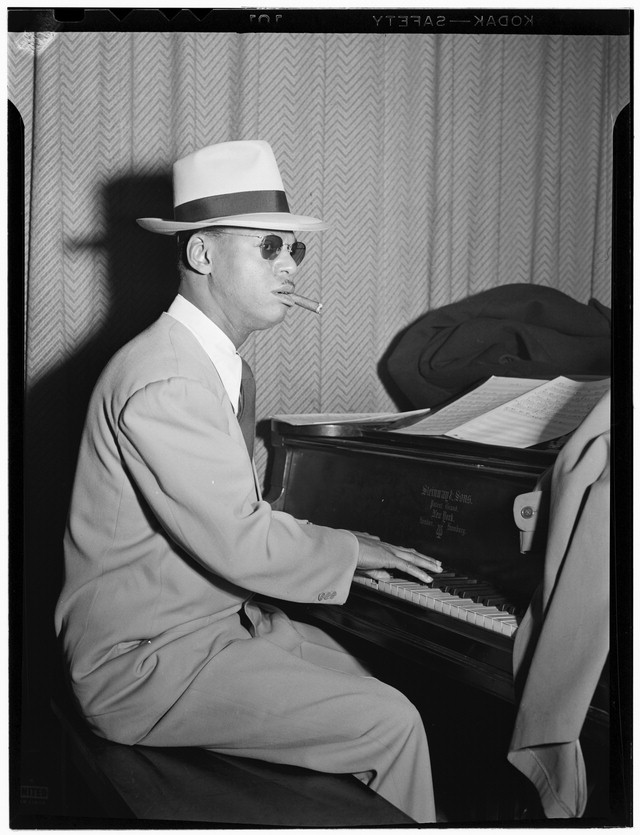Earl and Conlon

"I am an explorer." - Earl "Fatha" Hines (photo by William P. Gottlieb)
A lovely revelation; finally getting around to listening to the piano playing of Earl Hines, disclosing in a flash how Conlon Nancarrow didn't exaggerate one iota when raving about the music of his piano hero. Amazing how the very touch and sound personality of Conlon's player piano is entirely sprung from the jazz piano style invented by Earl Hines whose playing is characterized by gossamer rapidity and child-like joyfulness; honky-tonk piano ripples bespeaking simultaneously the American West, the American South, and salt water-fresh water tidal commingling of African American rural and urban milieus. Nancarrow takes his love for Hines, focusing on Earl's playfully exuberant-obsessive melodic-rhythmic complexity and nuance, and spins it further (or "Fatha" using the famous nickname of Hines) like three or more hummingbirds engaged in frenzied feeding or mating interactions often competitive in nature. Truth be told, I prefer the music of Hines over his prodigious, phenomenal admirer because by definition and intent Nancarrow's music is ultimately a form of study, while Hines allows his music to breathe, providing the elements of silence and repose to balance out the tempestuous and the labyrinthine.
Conlon Nancarrow
It’s amazingly unexpected and welcome to experience the music of a major jazz innovator for the first time referring to Hines. And there's nothing to be ashamed about for the delay because we are flooded with so much music not only from the entire history of jazz, but the entire history of Western classical, Indian classical, and Western rock, pop and folk, not to mention all the other musical forms and traditions clamoring for or hiding from our attention. Actually, it is the expressive nature of Earl's piano playing that intrigues me most; a quality that clearly hypnotized Nancarrow irrevocably, and that unique rasa-flavor has perhaps planted seeds I will explore in a future composition. Most of the writing about Nancarrow's music focuses on technical analysis (one would hope at least some of this illustrates phrases and passages from Hines also found in Nancarrow) while overlooking the uniquely captured elements that sparked him in the first place. Art Tatum is another jazz pianist Nancarrow admired, but I now find that influence much less centrally compelling in comparison to Hines who sounds totally "American", reflected in Nancarrow, while Tatum has much more "European" in his playing. Trumpet associations abound. Hines originally wished to play the cornet/trumpet, but found the sound too jarring being close to his ears, so he instead developed an expressive language of attack, articulation and accents for piano inspired by the golden horn's promise. Prior to focusing on composition, Nancarrow was a jazz trumpeter, and the excitingly transformative metal string fervor of Earl's sound demonstrated to Conlon how to synthesize brass power with santoor-descended keyboards. Following piano lessons, trumpet became my First Instrument at the age of nine, ending with a football accident splitting my upper lip, something that eventually healed. Trumpeters Rollan Masciarelli and Charlie Colin were shining lights of encouragement for me. Lastly, the trumpet improvisations of Dizzy Gillespie radiate eternally as the epitome of avant-garde spirit, virtuosity specific to maximizing one's chosen instrument, and synergizing irresistible concepts and sounds from foreign lands. Trembling Flowers (1985), March Wind (1985) and Fire Monkey (1985) are some early compositions of mine that others have compared to the music of Conlon Nancarrow. They were composed prior to my hearing his music for the first time.
Michael Robinson with the Meruvina (Beverly Hills, California 1991)
Emerald Anklets (2012) and Hummingbird Canyon (2014) are among myriad more recent compositions for Meruvina exhibiting comparable complexity in the greatly varied context of my subsequent experience with Indian classical music.
And, just like myself, Nancarrow stated that Indian classical music was a primary source of inspiration along with jazz together with African music. Speaking of which, check out Rainbow Thunder (1996) and Sun Dance (1992) courtesy of a Continent of Light - forget that Dark Continent nonsense.
- Michael Robinson, April 2019, Los Angeles
© 2019 Michael Robinson All rights reserved
Michael Robinson is a Los Angeles-based composer and writer (musicologist).
|